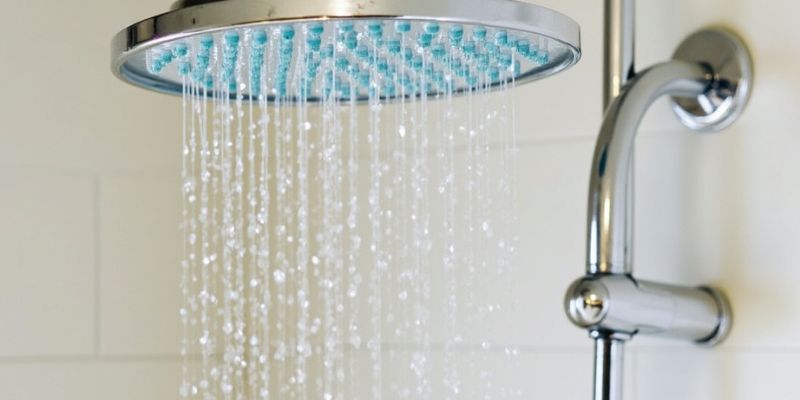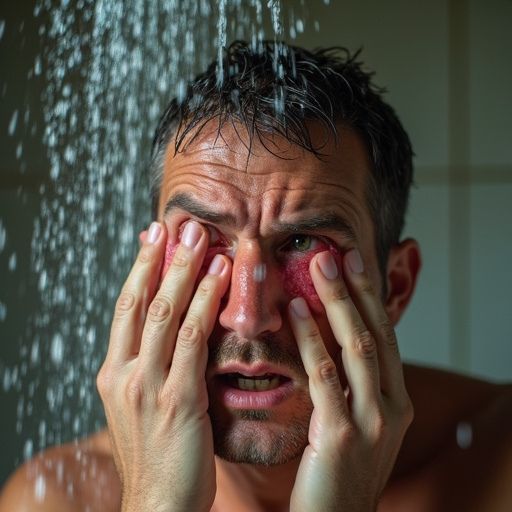13 Signs Your Showerhead Is Making You Sick (Health Warning #7!)
While you might think a showerhead is harmless since it’s constantly running with clean water, it can actually harbor dangerous bacteria that affect your health daily.
You’re probably exposed to these microscopic threats every time you step into your shower, breathing in potentially harmful microorganisms that could lead to respiratory issues, skin problems, and other concerning symptoms.
If you’ve noticed persistent coughing during your morning routine or unexplained rashes, your showerhead might be the culprit.
Understanding these warning signs isn’t just about maintaining hygiene—it’s about protecting yourself from serious health risks that could be lurking in your bathroom.

Persistent Upper Respiratory Infections
A contaminated showerhead can trigger recurring upper respiratory infections by dispersing harmful microorganisms directly into your airways during daily showers.
These pathogens, including Mycobacterium avium and Legionella pneumophila, thrive in the warm, moist environment of your showerhead’s interior, forming resilient biofilms that resist standard cleaning methods.
When you’re experiencing frequent sinus infections, bronchitis, or persistent coughing that won’t resolve with conventional treatment, your showerhead might be the culprit.
You’ll notice these symptoms intensify after showering, as you’re inhaling an aerosolized mist containing concentrated bacterial colonies.
The risk increases considerably if you’ve got a compromised immune system or pre-existing respiratory conditions.
Take control of your health by regularly disinfecting your showerhead using vinegar solutions or replacing it every 6-12 months.
Unexplained Skin Rashes

Microorganisms lurking within contaminated showerheads can lead to persistent skin conditions, particularly when biofilms release harmful bacteria onto your epidermis during daily showers.
The most common culprits include Mycobacterium avium and Pseudomonas aeruginosa, which can trigger unexplained rashes, eczema flare-ups, and dermatitis.
You’ll notice these skin issues typically appear on areas directly exposed to shower spray, such as your chest, back, and face.
The symptoms often include redness, itching, scaling, and small pustules that don’t respond to conventional skincare treatments.
If you’re experiencing recurring skin problems despite maintaining good hygiene, your showerhead might be harboring these pathogenic microorganisms.
Testing your shower water and inspecting your showerhead for pink or brown slime can help confirm whether bacterial colonization is the source of your skin concerns.
Pink Slime Around Showerhead
Over time, that pinkish-red residue accumulating around your showerhead isn’t rust or mineral deposits – it’s Serratia marcescens, a rod-shaped bacteria known for its distinctive pigmentation.
This opportunistic pathogen thrives in moist environments and can form biofilms on bathroom surfaces, particularly around water fixtures.
While S. marcescens isn’t typically dangerous for healthy individuals, it can pose risks if you’re immunocompromised or if the bacteria enter open wounds.
You’ll find this organism particularly active in bathrooms with poor ventilation, where humidity levels remain consistently high.
It’s resistant to many common cleaning products and can’t simply be wiped away.
To protect yourself, you’ll need to regularly clean your showerhead with a bleach solution or remove it completely for thorough disinfection.
Don’t let this bacteria establish a stronghold in your bathroom ecosystem.
Musty Bathroom Odors

Behind persistent musty odors in your bathroom lies a complex ecosystem of microbes thriving in contaminated showerheads.
These biofilms, composed of bacteria and fungi, release volatile organic compounds (VOCs) that create that characteristic earthy, damp smell you’re detecting.
When you notice these odors, you’re likely inhaling potentially harmful microorganisms with every shower.
Science confirms that Mycobacterium avium and other opportunistic pathogens commonly colonize showerheads, multiplying in the warm, moist environment.
The musty smell isn’t just unpleasant – it’s your body’s warning system detecting airborne bacterial byproducts.
You’ll need to take action quickly, as these biofilms become increasingly resistant to standard cleaning methods over time.
Don’t ignore these warning signs; they’re telling you it’s time to deep-clean or replace your showerhead before respiratory issues develop.
Low Water Pressure
A sudden drop in shower pressure might signal more than just an aging plumbing system – it often indicates significant bacterial buildup inside your showerhead.
When bacteria colonize and multiply within the showerhead’s internal components, they create biofilms that obstruct water flow through the nozzles.
You’ll notice this restriction gradually worsen over time as microorganisms like Mycobacterium avium and Legionella continue to proliferate.
These pathogens thrive in the warm, moist environment of your shower fixtures, creating dense colonies that block individual spray holes.
While you might be tempted to ignore reduced water pressure, it’s essential to address this issue promptly.
Left unchecked, these bacterial communities will continue expanding, potentially releasing harmful microorganisms into your shower’s water spray and compromising your respiratory health through aerosolized exposure.
Itchy Red Eyes

When your eyes become consistently red and itchy after showering, contaminated water droplets from your showerhead may be the culprit.
Microorganisms like Mycobacterium avium and Pseudomonas aeruginosa can thrive in the warm, moist environment of your showerhead, creating biofilms that release harmful particles directly into your eyes during showering.
These pathogens often trigger inflammatory responses in your conjunctiva, the membrane covering your eye’s surface.
You’ll notice increased sensitivity to light, burning sensations, and persistent redness that doesn’t resolve quickly.
If you’re experiencing these symptoms, analyze your shower water’s quality immediately.
Consider installing a certified antimicrobial filter or regularly cleaning your showerhead with vinegar solutions to eliminate bacterial colonies.
Don’t ignore these warning signs – untreated exposure can lead to chronic eye infections and more serious ocular complications.
Strange Metallic Taste
Noticing a metallic taste during or after showering signals potential corrosion within your showerhead’s internal components.
This taste often indicates the presence of dissolved metals, particularly iron, copper, or zinc, which have leached into your water supply through deteriorating pipes or fixtures.
You’ll want to pay special attention if you’re detecting this taste alongside rusty-colored water or metallic residue on your skin.
These dissolved metals, while not always immediately dangerous, can exceed EPA safety thresholds and potentially trigger adverse reactions in sensitive individuals.
Your body’s natural defense mechanisms might be warning you through this metallic sensation.
Don’t ignore this warning sign – it’s your right to have clean, safe shower water.
Test your water quality immediately and consider replacing your showerhead with a corrosion-resistant model featuring certified filtration technology.
Wheezing After Showering

Respiratory distress following your shower routine could indicate a serious problem with your showerhead’s microbial ecosystem.
When you’re experiencing post-shower wheezing, you might be inhaling aerosolized bacteria, particularly Mycobacterium avium and other nontuberculous mycobacteria (NTM), which thrive in the warm, moist environment of contaminated showerheads.
These opportunistic pathogens can trigger inflammatory responses in your respiratory system, leading to symptoms that mimic asthma or bronchitis.
You’ll want to pay attention if your wheezing occurs consistently after showering but subsides when you’re away from the bathroom.
Studies by the National Institutes of Health have linked biofilm buildup in showerheads to increased risks of respiratory infections, particularly in regions with treated municipal water systems where bacteria develop antimicrobial resistance.
Black Spots on Shower Walls
Besides wheezing, another telltale sign of a contaminated shower environment manifests as black spots spreading across your shower walls.
These dark patches typically indicate the presence of Stachybotrys chartarum, commonly known as black mold, which thrives in your shower’s warm, humid conditions.
You’ll notice these spots particularly in corners and grout lines where moisture lingers longest.
Black mold releases mycotoxins into your shower’s steam, which you’re then inhaling directly into your respiratory system.
Don’t ignore these warning signs – they’re not just cosmetic issues.
The CDC reports that exposure to black mold can trigger severe respiratory infections, chronic sinus problems, and cognitive issues.
You’re at higher risk if your bathroom lacks proper ventilation or if you don’t run your exhaust fan during and after showering.
Recurring Sinus Problems

With chronic sinus infections, your contaminated showerhead could be the hidden culprit.
When you’re exposed to bacteria-laden water vapor during showers, these microorganisms can directly enter your nasal passages and sinuses, triggering inflammatory responses and infections.
Studies have shown that Mycobacterium avium complex (MAC) and other opportunistic pathogens frequently colonize showerheads, creating biofilms that release harmful microorganisms with each shower.
You’ll notice recurring symptoms like nasal congestion, facial pressure, and postnasal drip that don’t respond to conventional treatments.
These infections often return because you’re repeatedly exposing yourself to the source.
To protect your respiratory health, you’ll need to either clean your showerhead regularly with a vinegar solution or replace it entirely.
Consider installing a filtered showerhead that’s designed to trap harmful bacteria.
Scalp Irritation
Persistent scalp issues could signal your showerhead is harboring harmful microorganisms.
When bacterial biofilms accumulate inside your showerhead, they release microscopic particles directly onto your scalp during each shower, potentially triggering inflammation, itching, and flaking.
Studies have identified Mycobacterium and Pseudomonas species as common showerhead colonizers that can cause scalp dermatomycosis and folliculitis.
You’ll notice symptoms like persistent dandruff that doesn’t respond to medicated shampoos, red patches, or unusual tenderness.
These microorganisms thrive in the warm, moist environment of your showerhead, especially if it’s made of plastic.
You can protect your scalp’s microbiome by installing a metal showerhead with antimicrobial properties, regularly disinfecting it with vinegar solutions, and replacing it annually.
Don’t compromise your scalp health by ignoring these warning signs.
Coughing During Showers

A recurring cough during your shower time may be more than just steam sensitivity – it could indicate exposure to aerosolized bacteria from your contaminated showerhead.
When water sprays through a bacteria-laden showerhead, it creates microscopic droplets that you can inhale directly into your respiratory system.
Your showerhead’s warm, moist environment provides an ideal breeding ground for Mycobacterium avium and other harmful microorganisms.
These pathogens form resilient biofilms inside the fixture and multiply rapidly.
You’ll notice the coughing tends to start shortly after beginning your shower and may persist for several minutes afterward.
To protect your respiratory health, you’ll need to regularly disinfect or replace your showerhead.
If you’ve been experiencing persistent shower-related coughing, it’s essential to address this potential health risk promptly.
Water Discoloration
Noticing discolored water from your showerhead serves as a critical warning sign of potential microbial contamination.
Brown, reddish, or yellow-tinged water typically indicates the presence of iron bacteria or rust particles, while green or blue tints suggest copper pipe corrosion.
These discolorations aren’t just aesthetic concerns – they’re potential health hazards.
When you observe pink or orange slime, you’re likely dealing with Serratia marcescens, a bacteria species that thrives in moist environments.
Black specks or particles often signal the presence of manganese or decomposing rubber gaskets.
If you’re seeing white or cloudy water, you’ve got mineral buildup, particularly calcium and magnesium deposits, which can harbor harmful bacteria in their crystalline structures.
Take immediate action by testing your water quality and replacing affected components.
FAQs
How Often Should I Replace My Showerhead to Prevent Bacterial Buildup?
You’ll want to replace your showerhead every 6-8 months, though you can extend its life by performing monthly cleanings with vinegar solution. Regular maintenance gives you control over potential bacterial colonization in your fixtures.
Can Using Filtered Water Prevent Harmful Bacteria From Growing in Showerheads?
Ever wonder what lurks in your pipes? While filtered water can reduce mineral buildup, it won’t completely prevent bacterial growth. You’ll still need regular cleaning and maintenance since bacteria can thrive in any moist environment.
What Temperature Setting Helps Minimize Bacterial Growth in Shower Systems?
You’ll minimize bacterial growth by setting your water heater to at least 140°F (60°C). However, be aware that you’ll need anti-scald devices, as this temperature can cause burns within seconds of exposure.
Are Certain Showerhead Materials More Resistant to Bacterial Contamination?
You’ll find that metal showerheads made of copper or brass naturally resist bacteria through oligodynamic action, while stainless steel and PVD-coated materials offer better protection compared to standard plastic or chrome-plated options.
Do Ultraviolet Water Treatment Systems Effectively Protect Against Showerhead Bacteria?
Like a shield against invisible invaders, UV water treatment systems can effectively eliminate up to 99.9% of showerhead bacteria. You’ll get protection as UV light disrupts bacterial DNA, preventing their reproduction and growth.
Final Thoughts
Your showerhead’s safety shouldn’t be secondary to style.
Scientific studies show systematic monitoring of shower systems prevents potentially perilous pathogens from proliferating.
You’ll need to regularly replace or rigorously clean your showerhead to reduce respiratory risks.
Testing for telltale troublemakers like Mycobacterium avium and Legionella pneumophila proves prudent, as these bacteria can become aerosolized and impact your immunological integrity.